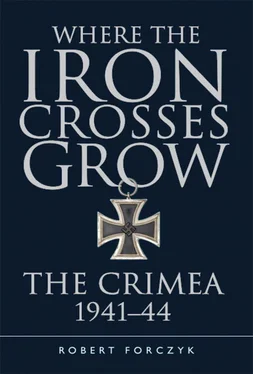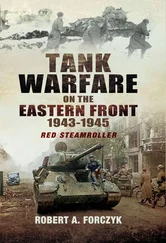Without air or naval support and their command and control gone, the Red Army units in the Crimea scattered like a flock of birds. The only intact unit was Colonel Evgeny I. Zhidilov’s 7th Naval Infantry Brigade, which had marched from Sevastopol to Simferopol. Zhidilov was an experienced combat veteran who had participated in the Soviet conquest of the Crimea in 1920, and his naval infantrymen were among the best Soviet troops in the Crimea. Yet by the morning of October 31, Ziegler’s motorized columns had already blocked the Simferopol–Sevastopol road and captured Bakhchisaray, cutting off Zhidilov’s brigade and Petrov’s Coastal Army. Lieutenant Ivan A. Eaika’s Coastal Battery No. 54, located north of the Kacha River, fired several rounds of 102mm fire at Ziegler’s motorized column, but without effect. [17] F. Perechnev and F. Vinogradov, Na strazhe morskikh gorizontov [ The Guardians of the Coast ] (Moscow: Soviet Mininstry of Defense, 1967), p. 42.
On the same day, Aufklärungs-Abteilung 132 captured Yevpatoriya, thereby cutting off most of the 321st Rifle Division. Zhidilov’s brigade put up a brief fight against the vanguard of the 72. Infanterie-Division north of Simferopol but then joined Petrov’s herd of retreating units, trying to evade the German dragnet by heading southeast through the Crimean Mountains to Alushta. The last three T-34 tanks were abandoned in Simferopol due to lack of fuel, as well as many other vehicles. By the end of the day, the 72. Infanterie-Division had occupied Simferopol. Before leaving Simferopol, however, the NKVD executed a number of prisoners, mostly Tatars or people with foreign heritage, who had been rounded up in September as part of the effort to clear the Crimea of “enemies of the people.” [18] Alan W. Fisher, The Crimean Tatars (Stanford, CA: Hoover Institute Press, 1978), p. 154.
After the fall of Dzhankoy, Sponeck’s XXXXII Armeekorps continued pursuing the 51st Army toward the Kerch Peninsula, while Salmuth’s XXX Armeekorps veered southward to pursue Petrov and clear the Black Sea coast. The Romanian 1st Mountain Brigade succeeded in getting across the Chongar Peninsula and also pushed directly south for the Black Sea. Hansen’s LIV Armeekorps advanced more slowly toward the northern approaches of Sevastopol with just the 50. and 132. Infanterie-Divisionen, while Salmuth sent the 72. Infanterie-Division on a wide sweep through the mountains to seize Yalta and then approach Sevastopol from the east along the coast road. The shortage of water had a major impact in slowing the German pursuit, particularly since the bulk of the artillery and supplies in the infantry divisions were dependent upon horse-drawn transport. Nevertheless, Gottlob H. Bidermann, then serving as an enlisted Panzerjäger in the 132. Infanterie-Division, noted that his division succeeded in marching over 30 miles per day during the pursuit phase. [19] Gottlob H. Bidermann, In Deadly Combat: A German Soldier’s Memoir of the Eastern Front (Lawrence, KS: University Press of Kansas, 2000), pp. 48–49.
Although Manstein preferred a rapid descent upon Sevastopol, his forces were simply not structured for rapid-pursuit operations. Neither the 50. nor 72. Infanterie-Division possessed a reconnaissance battalion, which was usually the basis for forming a Vorausabteilung (vanguard battalion) for pursuit operations. Instead, they were forced to form Vorausabteilungen from the motorized Panzerjäger and infantry-gun companies organic to infantry regiments, which barely amounted to 200–300 troops in a few dozen thin-skinned vehicles. Aside from Ziegler’s provisional brigade, Hansen’s only other fast asset was Aufklärungs-Abteilung 132, which was split between clearing the area around Yevpatoriya and advancing toward Sevastopol. At best, an Aufklärungs-Abteilung in an infantry division had about 600 troops in three squadrons, including one mounted on horses and another on bicycles or motorcycles. The battalion’s so-called “heavy squadron” had just three light armored cars, usually Sd. Kfz. 221, and a platoon each of towed 3.7cm Pak guns and 7.5cm infantry guns. These forces were not designed to punch through fortified lines or to operate more than 6 miles forward of supporting infantry and artillery.
It is a sad truth that war is very good to some people. Leutnant Erich Bärenfänger, the 26-year-old commander of 7. Kompanie of IR 123, was enjoying the pursuit. He was part of the Vorausabteilung of the 50. Infanterie-Division, and when the senior officer was wounded on the morning of November 2, Bärenfänger assumed command of the advance guard, which consisted of two rifle companies and a heavy-machine-gun platoon. The blond-haired, blue-eyed Bärenfänger was the prototypical Nazi, who had joined the SA at age 18 and received his commission just before the start of World War II. By the Crimean campaign, Bärenfänger already had three campaigns under his belt and he enjoyed a meteoric rise during the war, going from platoon leader to Generalmajor in six years. Pushing his troops to advance rapidly on their bicycles, horses, and a few captured vehicles, Bärenfänger’s point squad caught up with the rear of one of Petrov’s columns north of the Alma River on the afternoon of November 2. Imprudently, one Russian heavy-weapons column, with five trucks and 80 horse-drawn vehicles, halted to rest near a village without deploying proper security. Once apprised of their location by his scouts, Bärenfänger expertly maneuvered his companies into firing positions without being detected. When Bärenfänger gave the command to fire with all weapons, his heavy machine guns sliced into the enemy column, which disintegrated into chaos. By the end of the short action, Bärenfänger had captured an entire eight-gun artillery battery and 500 prisoners. [20] Franz Kurowski, Generalmajor Erich Bärenfänger: vom Leutnant zum General (Würzburg: Fleschig Verlag, 2007), pp. 65–70.
While lack of mobility hindered the German pursuit, the Soviet retreat was hindered by multiple problems. Retreats are very difficult for even a well-trained and disciplined army to conduct, and few Soviet commanders had demonstrated much aptitude for this kind of maneuver during Operation Barbarossa in 1941. Yet the 45-year-old Petrov proved to be an above-average commander who held most of his army together, despite a complete breakdown in communications and logistics. He managed to keep the bulk of the 25th, 95th, and 172nd Rifle Divisions and Zhidilov’s brigade together, moving southeast through mountain trails. He hoped to slide due west and reach the Kacha River north of Sevastopol, but the rapid advance of Brigade Ziegler discouraged this approach. Instead, he was forced to take the Coastal Army on a circuitous and time-consuming route through the mountains to reach Sevastopol from the east. Petrov was also aware that Levchenko had lost control of the situation, so he decided to move ahead of his troops to take command at Sevastopol. If the city fell, his army would be doomed. Leaving General-Major Trofim K. Kolomiets, commander of the 25th Rifle Division, to lead the retreating units, Petrov set out for Sevastopol. By late November 3, Petrov reached Balaklava, although most of his troops were strung out in the mountains and would not reach Sevastopol for another five days. The next day, the Stavka directed Petrov to temporarily take command of the Sevastopol Defensive Region (Sevastopolskogo Oboronitelnogo Raiona or SOR), until Oktyabrsky returned.
Levchenko apparently believed that Sevastopol could not be held for very long, and, like Oktyabrsky, began to quietly make plans to evacuate the naval base. The Stavka had authorized the bulk of the Black Sea Fleet to rebase at ports in the Caucasus, but had not sanctioned the evacuation of Sevastopol. Borisov, in charge of the KOS, recruited thousands of local civilians to complete trenches and antitank ditches on the city’s approaches that had been begun weeks before. He also issued orders to stockpile food in anticipation of a siege. The only bright spot was that the Fliegerkorps IV had withdrawn most of its air support after the victory at Ishun in order to support Kleist’s drive on Rostov, which left Manstein’s AOK 11 with minimal air support. Although a number of VVS squadrons retreated to the Caucasus, the VVS-ChF’s 62nd Fighter Brigade remained at Sevastopol and provided Petrov with air superiority over the city.
Читать дальше












